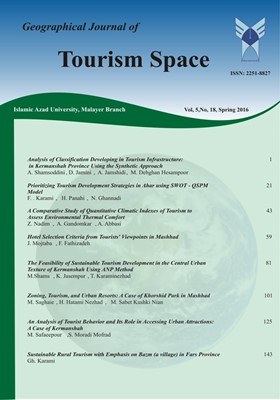An Analysis of Tourist Behavior and Its Role in Accessing Urban Attractions: A Case of Kermanshah
Subject Areas :
Keywords: Kermanshah, Leisure Time, Urban Tourism, spatial patterns,
Abstract :
Leisure is a new social area that in the context of modernity, contemporary social and cultural changes, and the growth of culture of consumerism, has realized its meaning and importance. Spending leisure time is one of the major functional areas in cities. The purpose of this article was an analysis of the leisure patterns in Kermanshah in order to find the right solution for leisure time development in the region. The obtained results showed that there was a direct relationship between leisure time, urban infrastructures, social- cultural attractions and the historical-natural attractions. The relationship between leisure time and other factors, i.e., historical, social-cultural attractions, urban infrastructure and natural attractions, according to the multivariate regression was 0.609, 0.089, 0.102 and 0.478. Thus, the highest correlation was between leisure time and historical attractions. Also using the Spearman method, it was seen that there was a significant and positive correlation between leisure time and urban infrastructures (r= 0.555) at the 0.99 of confidential level which meant that infrastructure was considered better than spending leisure time as far as the families satisfaction was regarded. Thus, the highest correlation using Spearman method was between leisure time and urban infrastructure. Also using one sample t -test, except for the dimensions of natural attractions in other cases proved the significant difference between the mentioned variables.

